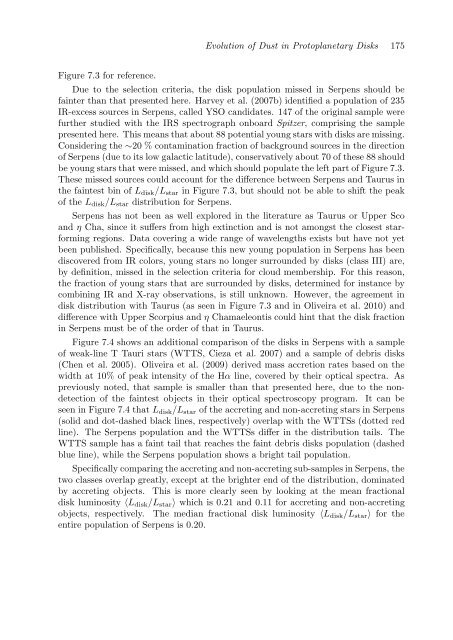Observational Constraints on The Evolution of Dust in ...
Observational Constraints on The Evolution of Dust in ...
Observational Constraints on The Evolution of Dust in ...
You also want an ePaper? Increase the reach of your titles
YUMPU automatically turns print PDFs into web optimized ePapers that Google loves.
Evoluti<strong>on</strong> <strong>of</strong> <strong>Dust</strong> <strong>in</strong> Protoplanetary Disks 175<br />
Figure 7.3 for reference.<br />
Due to the selecti<strong>on</strong> criteria, the disk populati<strong>on</strong> missed <strong>in</strong> Serpens should be<br />
fa<strong>in</strong>ter than that presented here. Harvey et al. (2007b) identified a populati<strong>on</strong> <strong>of</strong> 235<br />
IR-excess sources <strong>in</strong> Serpens, called YSO candidates. 147 <strong>of</strong> the orig<strong>in</strong>al sample were<br />
further studied with the IRS spectrograph <strong>on</strong>board Spitzer, compris<strong>in</strong>g the sample<br />
presented here. This means that about 88 potential young stars with disks are miss<strong>in</strong>g.<br />
C<strong>on</strong>sider<strong>in</strong>g the ∼20 % c<strong>on</strong>tam<strong>in</strong>ati<strong>on</strong> fracti<strong>on</strong> <strong>of</strong> background sources <strong>in</strong> the directi<strong>on</strong><br />
<strong>of</strong> Serpens (due to its low galactic latitude), c<strong>on</strong>servatively about 70 <strong>of</strong> these 88 should<br />
be young stars that were missed, and which should populate the left part <strong>of</strong> Figure 7.3.<br />
<strong>The</strong>se missed sources could account for the difference between Serpens and Taurus <strong>in</strong><br />
the fa<strong>in</strong>test b<strong>in</strong> <strong>of</strong> L disk /L star <strong>in</strong> Figure 7.3, but should not be able to shift the peak<br />
<strong>of</strong> the L disk /L star distributi<strong>on</strong> for Serpens.<br />
Serpens has not been as well explored <strong>in</strong> the literature as Taurus or Upper Sco<br />
and η Cha, s<strong>in</strong>ce it suffers from high ext<strong>in</strong>cti<strong>on</strong> and is not am<strong>on</strong>gst the closest starform<strong>in</strong>g<br />
regi<strong>on</strong>s. Data cover<strong>in</strong>g a wide range <strong>of</strong> wavelengths exists but have not yet<br />
been published. Specifically, because this new young populati<strong>on</strong> <strong>in</strong> Serpens has been<br />
discovered from IR colors, young stars no l<strong>on</strong>ger surrounded by disks (class III) are,<br />
by def<strong>in</strong>iti<strong>on</strong>, missed <strong>in</strong> the selecti<strong>on</strong> criteria for cloud membership. For this reas<strong>on</strong>,<br />
the fracti<strong>on</strong> <strong>of</strong> young stars that are surrounded by disks, determ<strong>in</strong>ed for <strong>in</strong>stance by<br />
comb<strong>in</strong><strong>in</strong>g IR and X-ray observati<strong>on</strong>s, is still unknown. However, the agreement <strong>in</strong><br />
disk distributi<strong>on</strong> with Taurus (as seen <strong>in</strong> Figure 7.3 and <strong>in</strong> Oliveira et al. 2010) and<br />
difference with Upper Scorpius and η Chamaele<strong>on</strong>tis could h<strong>in</strong>t that the disk fracti<strong>on</strong><br />
<strong>in</strong> Serpens must be <strong>of</strong> the order <strong>of</strong> that <strong>in</strong> Taurus.<br />
Figure 7.4 shows an additi<strong>on</strong>al comparis<strong>on</strong> <strong>of</strong> the disks <strong>in</strong> Serpens with a sample<br />
<strong>of</strong> weak-l<strong>in</strong>e T Tauri stars (WTTS, Cieza et al. 2007) and a sample <strong>of</strong> debris disks<br />
(Chen et al. 2005). Oliveira et al. (2009) derived mass accreti<strong>on</strong> rates based <strong>on</strong> the<br />
width at 10% <strong>of</strong> peak <strong>in</strong>tensity <strong>of</strong> the Hα l<strong>in</strong>e, covered by their optical spectra. As<br />
previously noted, that sample is smaller than that presented here, due to the n<strong>on</strong>detecti<strong>on</strong><br />
<strong>of</strong> the fa<strong>in</strong>test objects <strong>in</strong> their optical spectroscopy program. It can be<br />
seen <strong>in</strong> Figure 7.4 that L disk /L star <strong>of</strong> the accret<strong>in</strong>g and n<strong>on</strong>-accret<strong>in</strong>g stars <strong>in</strong> Serpens<br />
(solid and dot-dashed black l<strong>in</strong>es, respectively) overlap with the WTTSs (dotted red<br />
l<strong>in</strong>e). <strong>The</strong> Serpens populati<strong>on</strong> and the WTTSs differ <strong>in</strong> the distributi<strong>on</strong> tails. <strong>The</strong><br />
WTTS sample has a fa<strong>in</strong>t tail that reaches the fa<strong>in</strong>t debris disks populati<strong>on</strong> (dashed<br />
blue l<strong>in</strong>e), while the Serpens populati<strong>on</strong> shows a bright tail populati<strong>on</strong>.<br />
Specifically compar<strong>in</strong>g the accret<strong>in</strong>g and n<strong>on</strong>-accret<strong>in</strong>g sub-samples <strong>in</strong> Serpens, the<br />
two classes overlap greatly, except at the brighter end <strong>of</strong> the distributi<strong>on</strong>, dom<strong>in</strong>ated<br />
by accret<strong>in</strong>g objects. This is more clearly seen by look<strong>in</strong>g at the mean fracti<strong>on</strong>al<br />
disk lum<strong>in</strong>osity 〈L disk /L star 〉 which is 0.21 and 0.11 for accret<strong>in</strong>g and n<strong>on</strong>-accret<strong>in</strong>g<br />
objects, respectively. <strong>The</strong> median fracti<strong>on</strong>al disk lum<strong>in</strong>osity 〈L disk /L star 〉 for the<br />
entire populati<strong>on</strong> <strong>of</strong> Serpens is 0.20.
















